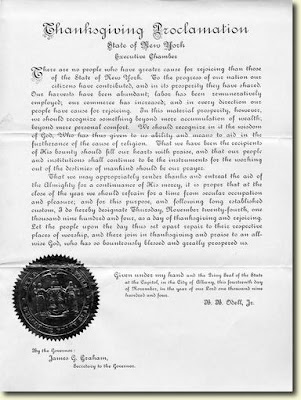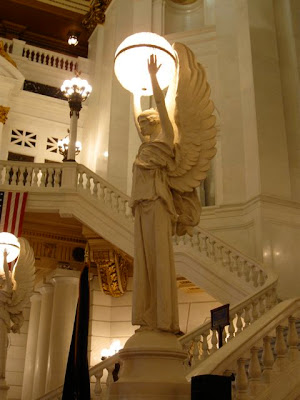The main entrance of the Capitol leads to a rotunda that features an impressive imperial staircase.
One of the light fixtures at the foot of the staircase.

The rotunda itself seems dazzling . . . until you look up. The interior of the dome features four allegorical medallions depicting Science, Religion, Justice, and Art, all of which were painted by Edwin Austin Abbey.

Abbey also painted the lunette murals, each of which symbolizes one of the state's contributions to modern civilization, at the base of the dome. The Spirit of Light is my favorite.

Henry Chapman Mercer of the Moravian Tile Works handcrafted the tile floor of the rotunda, which features hundreds of mosaics. Some of these mosaics, such as the steel mill scene above. depict Pennsylvania's industries and workers.

Other mosaics, such as this very Arts and Crafts dragonfly, depict the state's fauna.

I like bats -- they're beneficial, fascinating creatures, and they get a bad rap -- and I was particularly fond of this bat mosaic.
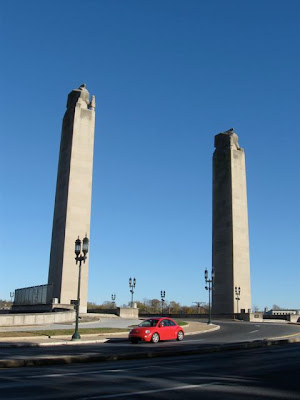
After I left the Capitol, I walked through the State Capitol Complex toward what turned out to be the pylons of the
State Street Bridge (also known as the Soldiers and Sailors Memorial Bridge), which was completed in 1930.

Art Deco eagles sit atop each pylon, one of which symbolizes the U.S. Army and one of which symbolizes the U.S. Navy. And this afternoon, flocks of pigeons sat atop each eagle.

I kept walking through the complex, and was captivated by the stunning
north facade of the Finance Building, which was designed by William Gehron and Sidney F. Ross, built by the Public Works Administration, and completed in 1939. The Lee Lawrie bas-relief in front of the entrance depicts Pennylvania's evolution from a place of nature to a modern industrial state.

In this section of the bas-relief, Justice stands guard over a working-class family.
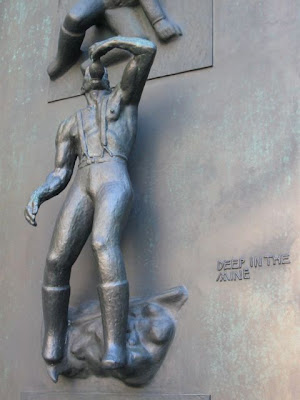
The mammoth bronze doors, created by Swedish sculptor Carl Milles, depict the state's agricultural heritage and its industrial strength. Above, a detail from the door to devoted to mining.

A detail from the door dedicated to the glass manufacturing.

The main entrance of the Northwest Office Building, which houses the State Liquor Control Board, features an impressive pair of eagles.

A side view of the State Capitol, taken from the north.

This mysterious-looking structure, which could have served an exterior location in the
Men in Black movies, is home to the
Pennsylvania State Archives. It was designed to house records, but it is suffering a host of
age-related problems and is almost completely full. Funding for a new archival facility has been authorized, but owing to the state's fiscal situation, monies have yet to be released.

The Second Baptist Church stands roughly opposite the State Archives. I find its small size and rough-hewn stone appealing.

North of the State Capitol Complex is a quiet neighborhood of consisting chiefly of rowhouses. These homes, some of which are extremely narrow, were no doubt built to house working-class people. However, the area now seems to have been gentrified.
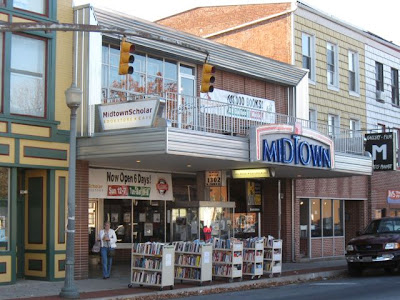
Just a few blocks north of the State Capitol Complex stands the astounding
Midtown Scholar Bookstore. Housed in a former movie theater, this place is a scholar's dream. I had a lovely light lunch at the Famous Reading Cafe, which is housed at the front of the store, and then spent a couple of hours perusing the shelves. I walked out with half a dozen books, including a couple of titles that I really wanted to purchase when I was in graduate school but simply couldn't afford at the time. If I hadn't forced myself to stay away from the art books, the damage would have been much worse. If you ever find yourself in Harrisburg, this is one place you won't want to miss.

After leaving the Midtown Scholar, I started making my way back to the Harrisburg Hilton, and passed the State Capitol a second time. The dome, which is covered with green-glazed ceramic tile and topped by Roland Hinton Perry's bronze, Commonwealth, was lit up for the evening.
